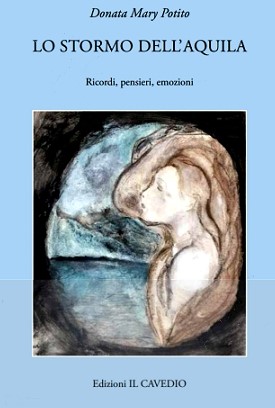The Healing Story, Between Fragility and Flight

In her intense The Flock of the Eagle, Donata Mary Potito writes with the awareness and courage of someone who has lived, suffered, loved, and chosen to tell her story.
It is a testimony that, through the evocative power of writing, becomes an act of healing. Healing of the self, of the other, and of memory. The text lends itself perfectly to a reading through the principles of narrative medicine, in which the story of illness (and healing) is integrated with personal biography to restore unity and meaning to lived experience.
The book opens on a threshold: a scene suspended between life and death. A car accident that shatters time, the body, and certainty. In those liminal moments, when the protagonist loses herself among voices, lights, and memories, the narration becomes vision: the mother’s voice, the call of childhood, the vertigo of loss. But also the distant sound of a song by Battiato: “Eagles don’t fly in flocks.” A phrase that runs through the entire book and becomes its deep symbol.
The eagle, emblem of solitude and height, embodies the fragile strength of inner flight. Eagles, as we know, do not gather, do not blend into the group. They fly high, alone, capable of withstanding the currents of pain and sudden joys. With this awareness, the author leads us through her narrative: a flock of memories, yes, but each with its own rhythm, its own trajectory.
After the initial trauma, the protagonist – Marina – retraces her life as if she were seeing it again from a new height, from that suspended ridge that separated her from (and brought her back to) life. It is here that the story takes shape as therapeutic narrative: each episode is a stitched fragment, a wound recounted, a knot untied through words.
Relationships represent the supporting structure of her existence: family bonds, deep friendships, complicities, betrayals. The story of Peter – a key figure and at the same time a metaphor for passionate and complex love – is not at the exclusive center of the book, but acts as a sounding board for other dynamics: desire, disillusionment, growth. Their relationship is presented with honesty and poetry, without giving in to sentimentality. There is no need to reveal the outcome of that story to understand that every meaningful relationship leaves a mark, and that every crack can turn into a fissure of light.
But The Flock of the Eagle is much more than a story of love and wounds. It is also, and above all, a book about healing: of one’s inner self, of the wounded body, of the affections that remain. The protagonist is a doctor, but becomes a patient. From health professional to fragile woman facing illness, physical pain, and an oncological diagnosis. In this dual role, the book sheds light on a truth often forgotten: those who care for others also need to be cared for. And not only from a clinical point of view, but also on an existential, emotional, and symbolic level.
The reader thus enters an intimate yet never self-referential narrative fabric. The individual experience becomes universal. Every page suggests that speaking of illness does not mean only recounting a failing body, but also exploring a changing identity, a resurfacing past, and redefined priorities.
In this sense, the text becomes narrative medicine in its truest form: not just a story about illness, but a story with illness. A narrative that helps the protagonist give order, voice, and meaning to a traumatic experience, and offers the reader a chance to reflect on their own.
Potito’s writing is clear, ironic, at times lyrical. The chapters flow like waves: some gentle and melancholic, others angry and full of life. Images of the sea, the mountains, the wind, and solitude alternate with everyday and family scenes. There are moments of irony, as well as moments of pure tenderness – such as those dedicated to the dog Jung, a true life companion, a therapeutic presence on par with human beings.
The Flock of the Eagle is, ultimately, a courageous and profound memoir. A book that shows how writing can become healing, how the body and the word can be reassembled in a story. And how, even in pain, one can learn to fly again.
Link to the book (in Italian) ›› Lo stormo dell’aquila
